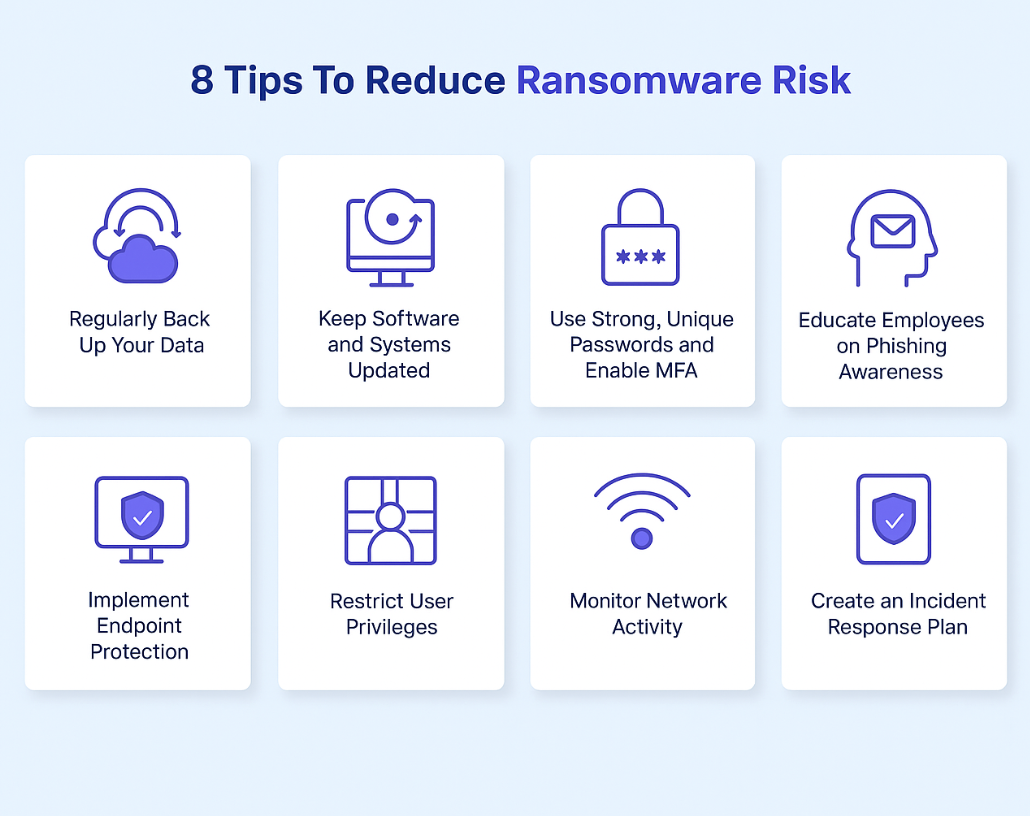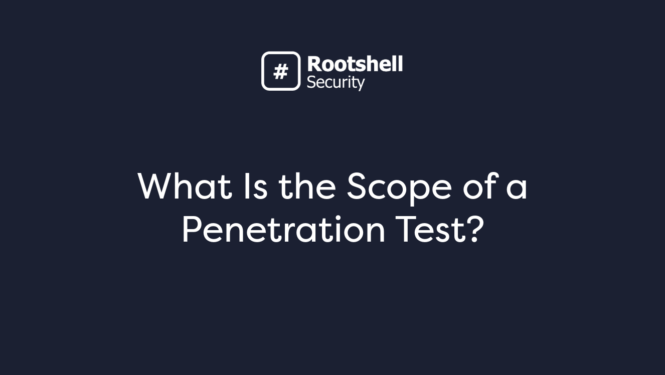Ransomware attacks have become one of the most pressing cybersecurity threats for businesses of all sizes. The FBI’s Internet Crime Complaint Center (IC3) released its 2024 Internet Crime Report and accompanying state reports. This latest report includes information from 859,532 complaints of suspected internet crime and details reported losses exceeding $16 billion, a 33% increase in losses from 2023.
This shows that for small and medium-sized enterprises (SMEs), the impact can be devastating, often leading to operational downtime, reputational damage, and financial loss.
This guide provides a detailed overview of ransomware, its mechanisms, business-focused mitigation strategies, and practical recovery guidance.
What is Ransomware
Ransomware is a type of malware designed to block access to a computer system, files, or data until a ransom is paid to the attacker.
It’s essentially digital extortion: the attacker encrypts your data or locks your system and demands payment—often in cryptocurrency—in exchange for restoring access.
Types of Ransomware:
- Crypto Ransomware: Encrypts files meaning that he user cannot access them without a decryption key.
- Locker Ransomware: Locks the device completely, preventing any system access.
- Scareware: Pretends there’s a problem (like fake antivirus alerts) and demands payment to “fix” it.
The Life Cycle of a Ransomware Attack
Ransomware attacks follow a predictable pattern, often unfolding in multiple stages. Understanding these phases can help organisations identify threats early and respond effectively.
Initial Infection
The first phase begins when ransomware gains access to a system. This usually happens through phishing emails, malicious downloads, compromised websites, or software vulnerabilities.
Attackers often disguise the malware as legitimate files or software to trick users into executing it.
Propagation
Once inside the system, the ransomware spreads across networks, targeting other devices and servers. This allows attackers to maximise the impact, potentially infecting critical infrastructure, shared drives, and backups.
Control Communication
In many cases, ransomware communicates with a remote server controlled by the attackers. This “command and control” stage allows the malware to receive instructions, such as which files to encrypt and which systems to target next.
Encryption and Lockdown
At this stage, the ransomware encrypts files, locks devices, or both, rendering data inaccessible. Some strains may display a ransom note on-screen, demanding payment in exchange for a decryption key.
Attackers often set deadlines, threatening permanent data loss to pressure victims into paying.
Extortion and Recovery
The final phase focuses on extortion. Attackers demand ransom payments, typically in cryptocurrency, while victims must decide whether to pay or restore from backups. Recovery can be lengthy and costly, involving IT remediation, forensic investigations, and system restoration.
Organisations may also face legal and reputational consequences if sensitive data is exposed.
8 Top Tips To Mitigate a Ransomware Attack
Ransomware attacks are becoming more common and more sophisticated, disrupting businesses of all sizes.
While no system is completely safe, putting proactive measures in place can mitigate your risk and limit the impact if an attack occurs. Here are eight practical steps to help protect your organisation against ransomware attacks:

1. Regularly Back Up Your Data
Keep offline backups of important files so you can recover data without paying a ransom. Test backups regularly to make sure they work.
2. Keep Software and Systems Updated
Install patches and updates promptly for operating systems, applications, and security tools to close known vulnerabilities.
3. Use Strong, Unique Passwords and Enable MFA
Use complex passwords and enable multi-factor authentication (MFA) to protect user accounts from unauthorised access.
4. Educate Employees on Phishing Awareness
Train staff to recognise suspicious emails, attachments, and links, one of the most common delivery methods for ransomware.
5. Implement Endpoint Protection
Use reputable antivirus and endpoint detection and response (EDR) tools to detect, isolate, and remove threats quickly.
6. Restrict User Privileges
Limit admin rights and apply the principle of least privilege to reduce potential damage if an account is compromised.
7. Monitor Network Activity
Set up intrusion detection systems and log monitoring to identify unusual activity early and contain potential threats.
8. Create an Incident Response Plan
Develop and regularly update a ransomware response plan so your organisation can act quickly and minimise downtime in the event of an attack.
The Importance of Protecting Against Ransomware
The impact of ransomware can be severe, affecting individuals, businesses, and even infrastructure. It’s not just about paying a ransom; ransomware can cause financial, operational, and reputational damage. Here’s a detailed breakdown:
Financial Protection
Victims may face ransom demands reaching millions of dollars, along with additional expenses for system restoration, IT support, and potential regulatory fines. Implementing strong security measures to prevent attacks is a lot more cost-effective than dealing with the aftermath.
Operational Continuity
A ransomware attack can bring business operations to a standstill, locking systems and data. Preventative measures, such as regular backups, network segmentation, and up-to-date software, ensure that organisations can continue running smoothly even if an attempted attack occurs.
Protecting Sensitive Data
Ransomware often targets confidential information, including customer records, financial data, and intellectual property. Protecting systems against such attacks helps prevent data breaches, maintain compliance with regulations, and preserve customer trust.
Reputation and Trust
Beyond immediate financial and operational impacts, ransomware can severely damage a company’s reputation. Customers and partners are less likely to trust organisations that have suffered preventable cyber incidents. Investing in protection demonstrates a commitment to security and reliability.
10 Practical Steps Companies Can Take If Attacked
Preventing ransomware attacks saves far more than paying for recovery.. A single attack can lead to weeks of downtime, loss of client trust, regulatory fines, and legal liabilities. Prevention is particularly important for SMEs that may lack the resources of larger enterprises.
Good prevention strategies align with established frameworks. These frameworks provide structured guidance for identifying, protecting, detecting, responding, and recovering from cyber threats. Here are some immediate steps you can take to reduce damage and recover quickly:
1. Isolate the Infection
Immediately disconnect affected devices from the network to prevent the ransomware from spreading. Disable Wi-Fi, VPN connections, and cloud syncs for compromised systems. Identify which systems and servers are affected to contain the attack.
2. Activate Incident Response Plan
If your company has an incident response (IR) plan, activate it immediately. Assemble your cybersecurity team or external experts to assess the situation and coordinate recovery. Notify executive leadership and relevant departments, including legal and communications teams.
3. Do Not Pay the Ransom Immediately
Paying ransom does not guarantee data recovery and may make the company a target for future attacks.
According to the U.S. Department of the Treasury, paying ransomware attackers may violate sanctions if funds are transferred to sanctioned entities. There is also no guarantee that attackers will provide decryption keys or remove stolen data.
Businesses should weigh the potential cost of payment against recovery through backups and professional support.
- Identify the Ransomware Variant
Work with cybersecurity professionals like Rootshell Security to determine the type of ransomware and its behaviour. Certain ransomware variants have free decryption tools available from organisations like No More Ransom.
5. Notify Law Enforcement
Contact local or national law enforcement (e.g., NCSC in the UK, FBI in the US) to report the attack. They can provide guidance, investigate the incident, and sometimes help trace the attackers.
6. Preserve Evidence
Document everything: screenshots, logs, ransom notes, emails, and infected files. Avoid tampering with affected systems before experts have examined them, as this can be important for investigations and potential legal proceedings.
7. Assess Backup and Recovery Options
Evaluate your backups to see if clean copies of the encrypted data exist. Restore from backups only after ensuring systems are fully clean of malware. Avoid restoring backups directly onto compromised systems.
8. Communicate Transparently
Notify affected stakeholders, including employees, customers, and partners, especially if personal data may have been exposed. Prepare internal and external communications carefully to maintain trust and comply with regulations like GDPR.
9. Conduct a Post-Incident Review
Identify how the attack occurred (e.g., phishing, unpatched vulnerabilities). Review and strengthen security controls:
- Update software and systems regularly.
- Implement multi-factor authentication (MFA).
- Conduct employee training on phishing and cybersecurity hygiene.
- Improve network segmentation and endpoint protection.
10. Consider Cyber Insurance and Legal Guidance
If you have cyber insurance, contact your provider immediately to understand coverage.
Consult legal counsel to manage compliance, breach notifications, and liability issues.
Following a structured incident response plan based on the NIST Incident Response lifecycle helps keep order during the crisis.
How Long Does It Take to Recover From Ransomware?
The time it takes to recover from a ransomware attack varies widely depending on several factors, including the size of the organisation, the type of ransomware, the extent of the infection, and the preparedness of the IT and cybersecurity teams.
Here’s a detailed breakdown:
Factors That Affect Recovery Time
- Extent of the Infection: If ransomware has spread across multiple systems or servers, recovery can take days to weeks. Limited infections on a few endpoints may be resolved in hours to a couple of days.
- Availability and Quality of Backups: Companies with up-to-date backups can restore operations within 1–3 days. Organisations without reliable backups may face weeks or months of downtime while rebuilding systems.
- Ransomware Variant: Some ransomware types are easier to decrypt, while others are more sophisticated, requiring extensive investigation and technical effort.
- IT and Cybersecurity Preparedness: Organisations with a clear incident response plan and a dedicated cybersecurity team can contain incidents and recover more quickly. Companies without structured response plans may experience extended downtime and operational disruption.
- Data Sensitivity and Compliance: If sensitive or regulated data is involved, extra forensic analysis and regulatory reporting can add time before normal operations resume.
Typical Recovery Timelines
Small businesses with backups: 1–3 days.
Medium-sized businesses with partial backups: 3–7 days.
Large enterprises or heavily encrypted systems: 2–6 weeks or longer.
Recovery with no backups: Could take months, depending on the complexity of decrypting files or rebuilding systems from scratch.
Best Practices for Ransomware Recovery
Recovery is most successful when businesses follow structured approaches:
- Maintain multiple backup copies: Adopt the 3-2-1 rule: three copies, on two media types, one offsite.
- Regularly test backups: Verify that recovery procedures work as intended.
- Segment networks: Limit access between critical systems and general user networks.
- Educate employees: Train staff to identify phishing and suspicious files.
- Monitor systems continuously: Implement intrusion detection systems (IDS) and endpoint monitoring.
- Review access controls: Enforce the principle of least privilege for all users.
These practices support not only recovery but also prevent recurrence of attacks.
How to Create an Effective Ransomware Recovery Plan
Step 1. Assess Assets and Risks
- Identify systems, data, and applications essential to operations.
- Conduct a risk assessment to understand which systems are most vulnerable to ransomware.
Step 2. Develop an Incident Response Team
- Form a dedicated response team including IT, cybersecurity, legal, and communications staff.
- Assign clear roles and responsibilities for decision-making during an attack.
Step 3. Establish Backup and Recovery Procedures
- Implement regular, segmented, and secure backups of all critical data.
- Test backups periodically to ensure they can be restored quickly and cleanly.
Step 4. Create Containment and Isolation Protocols
- Define steps to isolate infected devices immediately.
- Prepare network segmentation strategies to prevent ransomware from spreading.
Step 5. Define Communication Plans
- Establish clear internal and external communication channels.
- Plan notifications for employees, customers, partners, and regulatory bodies.
Step 6. Prepare Legal and Regulatory Guidelines
- Include steps to comply with data protection laws such as GDPR.
- Consult legal counsel on reporting breaches and managing liability.
Step 7. Include Decryption and Recovery Options
- Keep a list of trusted decryption tools and recovery solutions.
- Identify when to restore from backups vs. decryption tools.
Step 8. Conduct Regular Training and Simulations
- Train employees on ransomware risks and response protocols.
- Run mock ransomware drills to test the plan and identify weaknesses.
Step 9. Review and Update the Plan Regularly
- Update the plan to account for new ransomware threats and changes in IT infrastructure.
- Incorporate lessons learned from real incidents or drills.
Protect Your Business from Ransomware Today
Ransomware poses a serious threat to businesses of all sizes, but with proactive strategies, structured recovery plans, and employee awareness, organisations can mitigate their risk and recover if an attack occurs. Implementing strong backups, keeping systems updated, and following best practices for detection and response are all important steps toward protecting your data, operations, and reputation.
To find out how expert cybersecurity solutions can help, book a demo with Rootshell Security today.
Frequently Asked Questions
Can’t find the answer to your question?
You can always Contact Our Team of experts for a chat!
What is the difference between malware and ransomware?
Yes, with proper planning, offline backups, and incident response, SMEs can recover without paying the ransom.
Can small businesses survive a ransomware attack?
Yes. Automation helps contain threats instantly and speeds up remediation steps. However, human expertise is still important in complex cases.
Are ransomware attacks illegal?
Yes, ransomware attacks are criminal activities under national and international law, often prosecuted as cybercrime.
How can businesses prevent ransomware?
Regular software updates, employee training, endpoint monitoring, multi-factor authentication, network segmentation, and secure backups reduce risk.
Is paying the ransom recommended?
Payment is discouraged due to legal, financial, and ethical risks. Recovery should focus on backups and professional incident response.
Can ransomware spread to cloud services?
Yes, ransomware can infect cloud-synced files if proper segmentation and security controls aren’t in place.
How often should backups be tested?
Backups should be tested regularly to ensure they can be restored quickly and safely in the event of an attack.



